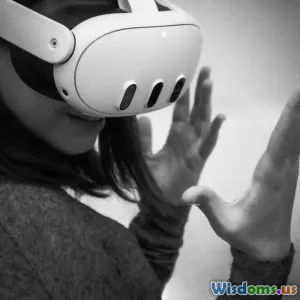
The Future of Augmented Reality in Gaming
8 min read Explore how augmented reality is revolutionizing gaming with immersive tech, new gameplay, and real-world interaction. (0 Reviews)
The Future of Augmented Reality in Gaming
Augmented Reality (AR) is no longer a futuristic concept reserved for sci-fi movies. It has progressively merged digital content with our physical surroundings, transforming the way we interact with technology. Among its most promising applications, gaming stands out as a fertile ground where AR is redefining entertainment by offering immersive, dynamic, and interactive experiences. But what exactly does the future hold for AR in gaming? This article takes an in-depth look at this evolving landscape, exploring innovations, industry drivers, real-world examples, and the challenges ahead.
Introduction: The Rise of Augmented Reality in Entertainment
AR, fundamentally, overlays digital information onto the real world through devices like smartphones, AR glasses, or headsets. This convergence allows for an enriched sensory experience, which gaming leverages to unusual effect. The phenomenal success of games like Pokémon GO in 2016 highlighted AR’s potential to catapult gaming beyond screens and into our environments. With over 147 million monthly active users during its peak and more than $1 billion revenue in its first two years, Pokémon GO underscored AR’s mass appeal.
Such popularity has spurred developers and tech companies to experiment boldly, propelling AR game design into unexplored domains. But gaming in the AR era is not just a momentary novelty; it’s shaping the evolutionary trajectory of interactive entertainment.
The Technology Driving AR Gaming Forward
Advanced Hardware: The AR Glasses Revolution
A pivotal driver of AR's future in gaming lies in hardware improvements. Lightweight, high-resolution AR glasses are replacing bulky headsets, enabling more comfortable, extended gaming sessions. For instance, Meta’s Quest Pro and Microsoft's HoloLens 2 offer sophisticated spatial computing by blending real-world environments with 3D virtual objects that gamers can interact with in real-time.
These devices support high frame rates, expansive fields of view, and precise environment mapping through simultaneous localization and mapping (SLAM) technologies. As companies continue to reduce cost and size, AR glasses will become more accessible, ushering in everyday AR gaming applications beyond controlled settings.
Artificial Intelligence Meets AR
AI integration enhances AR gaming by personalizing experiences and creating responsive, adaptive gameplay. Games powered by AI can analyze player behavior patterns and environmental variables to dynamically adjust challenges or storylines. Ubisoft’s upcoming projects include AR games that leverage AI to generate context-aware narratives and responsive NPCs (non-player characters), enriching immersion.
Moreover, AI facilitates real-time environment recognition, improving object placement stability and interaction fluidity within AR games, thus overcoming previous technical limitations like jitter and lag.
New Frontiers: Game Design Innovations in AR
Blurring Lines Between Virtual and Physical Worlds
Future AR games will move beyond simple overlays to create deeply intertwined virtual and physical experiences. For example, games could integrate multifaceted sensory feedback, including haptic suits and spatial audio, to stimulate sight, touch, and sound cohesively, transforming urban spaces, parks, or homes into game arenas.
Imagine an AR-based RPG where missions depend on physical movement through city streets while interacting with virtual enemies strategically placed on landmarks or parks, guiding players through a rich storyline that physically unfolds around them.
Persistent and Location-Based Experiences
Building on Pokémon GO’s success, persistent AR worlds anchored to real-world locations will become more prominent. These experiences allow long-term players to influence virtual ecosystems mapped onto physical places, creating communities unified by place and play.
Niantic’s Lightship platform exemplifies this approach, empowering developers to build multiplayer AR games that use real-time location data and environmental understanding. Such worlds promote social engagement as players collaborate or compete within contextually rich public spaces.
Industry Adoption and Insights
Beyond consumer entertainment, AR gaming is becoming an arena for brands to merge marketing with play. Major corporations like Nike and Coca-Cola have used AR gaming specific campaigns for interactive advertisements and limited edition virtual collectibles—engaging younger demographics more effectively than traditional ads.
Furthermore, industry analyst firm Newzoo forecasts that AR gaming revenues will surpass $10 billion by 2025, driven by mobile AR hardware and platform development. This signals robust growth potential, incentivizing continued investment and innovation.
Challenges and Opportunities Ahead
While AR gaming’s potential is vast, significant challenges must be addressed:
- Hardware Accessibility: Despite advances, AR glasses' price points and comfort still hinder mass adoption.
- Battery Life and Performance: Sustained AR gaming drains device batteries quickly and requires high processing power, constraining lengthy play.
- Privacy and Safety: Location-based AR gaming raises privacy issues and physical safety concerns, especially in densely populated or restricted areas.
- Content Quality and Diversity: To retain players, compelling content that caters to diverse tastes is essential.
Addressing these issues demands collaborative innovation among developers, hardware manufacturers, regulators, and communities.
Conclusion: A New Era for Immersive Entertainment
The trajectory of augmented reality in gaming is poised to transform entertainment fundamentally. As hardware matures, AI integration deepens, and game design evolves toward blending physical and virtual realities, players will enjoy experiences that are increasingly immersive, interactive, and personalized.
The future where our cities become playgrounds and everyday environments morph into live gaming landscapes is on the horizon. For developers, investors, and players alike, understanding and embracing this change will be key to unlocking unprecedented realms of creativity and connection.
As renowned AR pioneer Ori Inbar aptly puts it: “AR adds the magic into moments, giving us the power to create worlds within our own – that’s the real future of gaming.”
Will you be ready to play in this augmented tomorrow?
Rate the Post
User Reviews
Popular Posts




















